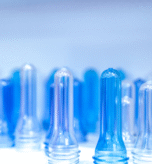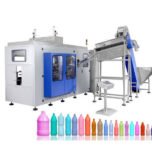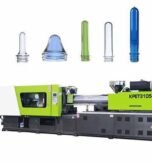When it comes to plastic preform packaging, especially for beverages, oils, and pharmaceuticals, size really does matter. And no, we’re not talking about the final bottle. We’re talking about PET preform sizes. These tiny tube-like structures determine everything from your bottle’s shape to its capacity, durability, and shelf appeal. In fact, choosing the wrong PET preform size can lead to everything from product leaks to production line hiccups.
In India’s competitive FMCG and packaging market, manufacturers are constantly looking to optimise PET preform design for better strength, lower costs, and perfect fit. But many buyers, especially new ones, don’t fully understand how preform dimensions influence bottle manufacturing.
We’ll walk you through everything you need to know about PET preform sizes, how to interpret them, what’s standard, and how to choose what’s right for your product line. Because PET preform standard sizes could save you money, reduce waste, and improve product performance.
By the end of reading this, you’ll not only be able to buy PET preforms with confidence, you’ll be sourcing smarter and saving better.
What Is a PET Preform? Quick Recap Before We Dive In
Before we get too technical, let’s refresh the basics. A PET preform is a semi-finished plastic piece made from Polyethylene Terephthalate (PET) resin. It’s essentially a test-tube-shaped mould that gets reheated and blown into a final plastic bottle using an Injection Stretch Blow Moulding (ISBM) process.
Why this two-stage approach? It allows manufacturers to mass-produce standardised shapes, transport them efficiently, and then mould them into various bottle sizes at the destination, making the supply chain faster and cheaper.
PET preform design typically includes:
-
- A neck finish (the part that determines what cap fits)
-
- A body that expands into the bottle shape
-
- Specific gram weight, which determines how much resin is used and how thick the bottle walls will be
Globally and in India, the demand for PET preforms is rising due to their recyclability, cost-efficiency, and versatility in beverage, oil, and pharmaceutical packaging. According to IMARC Group, in FY2022, India’s total PET production capacity exceeded 3,400 kilotons.
In short, PET preforms are the foundation of your final packaging, and size is the first thing you need to get right.
Understanding PET Preform Sizing: It’s Not Just About Weight
A common misconception among first-time buyers is that PET preform sizes are only about weight. While weight is crucial, three major parameters define a PET preform’s size:
-
- Gram Weight
This refers to the actual weight of the preform (in grams). It affects how thick and strong the final bottle will be. For instance:
-
- 9g preform may make a 250ml water bottle
-
- 20g preform might make a 1L carbonated beverage bottle
-
- Neck Diameter
This defines the mouth of the bottle and what kind of cap will fit it. For example:
-
- 28mm Alaska neck is common for water bottles
-
- 38mm necks are used for juices or oil bottles
-
- Preform Length
The length of the preform determines how tall the bottle can stretch. Longer preforms can be used for taller bottles or larger volumes.
So when we talk about PET preform standard sizes, we’re really talking about a combination of these three factors and getting the combo wrong can affect everything from bottle compatibility to blow moulding efficiency.
Remember, PET preform design must always align with your end-use product, the cap you’re using, and even your filling line machinery.
-
- Common PET Preform Sizes in the Indian Market
India’s packaging industry, especially in Gujarat, Maharashtra, and Tamil Nadu, uses a wide variety of PET preform sizes depending on product type and market segment.
Here are some common preform size combinations you’ll find in the Indian market:
| Bottle Volume | Preform Weight | Neck Type | Typical Use |
| 200ml | 8–9 grams | 28mm Alaska | Water / Juice Bottles |
| 500ml | 11–13 grams | 28mm Alaska / PCO | Water / Flavoured Drinks |
| 1 Litre | 19–23 grams | PCO 1810 or 1881 | Carbonated Drinks / Oils |
| 2 Litres | 28–32 grams | 3-Start / Wide Neck | Soda / Edible Oil |
| 5 Litres | 50–70 grams | 38mm or Wide Mouth | Bulk Water / Oil Packs |
Why does this matter? Because if you’re sourcing preforms for a new product, starting with PET preform standard sizes gives you access to existing moulds, better pricing, and easier cap compatibility.
These sizes are considered industry-friendly because they fit automated filling lines and caps readily available across India.
-
- Neck Sizes Explained: Alaska, PCO 1810, PCO 1881, 3-Start & More
Neck size might seem like a small detail, but it’s actually one of the most important parts of PET preform design. The neck determines:
-
- What type of closure/cap you can use
-
- Whether the bottle can handle pressure (like for sodas)
-
- How your label and sleeve will sit on the bottle
Here’s a breakdown of popular PET preform neck sizes used in Indian packaging:
 28mm Alaska Neck
28mm Alaska Neck
Most common for still water and juices. Lightweight and cost-effective. Not ideal for carbonated drinks.
 PCO 1810
PCO 1810
Heavy-duty. Used for carbonated beverages like soda and sparkling water. Supports high-pressure sealing.
 PCO 1881
PCO 1881
A lightweight version of 1810. Used for cost-saving without compromising strength. Good for sodas and flavoured water.
 3-Start Neck
3-Start Neck
Used in edible oils and some bulk packaging. Supports tamper-evident caps and offers better grip.
 38mm / Wide Mouth
38mm / Wide Mouth
Common in 5L water jars or edible oil packs. Allows for high-volume pouring and faster filling speeds.
Choosing the right PET preform neck size is key to minimising leakage, improving shelf life, and making sure your product works smoothly on the filling line.
How to Choose the Right PET Preform Size for Your Product
Choosing the correct PET preform size is part science, part strategy. Whether you’re bottling water, oils, or pharma products, matching the preform size to your product’s requirements ensures compatibility across production, shipping, and retail display.
Here’s a simple decision-making framework:
| Factor | What to Consider |
| Bottle Volume | 200ml? 500ml? 20L? DRJ offers preform weights from 6.2g to 700g |
| Neck Type | Alaska for water, Short Neck (26/22) for oils, 55mm for bulk water |
| Filling Method | Is your line high-pressure? Opt for thicker preforms (13g–20g) |
| Storage Needs | Long shelf life = stronger bottle walls = heavier preforms |
| Cap Compatibility | Make sure your cap supplier matches the neck size (thread count, height) |
Custom vs. Standard Preform Sizes: What Should You Choose?
Standard Preform Sizes (like 9.4g / 28mm Alaska or 18g / 28mm Short Neck) are ideal if:
-
- You want fast delivery
-
- You’re using standard capping/filling lines
-
- You want lower upfront costs
Custom PET Preform Design might be worth the investment if:
-
- You’re launching a new product line with specific shelf or packaging needs
-
- You need branding embedded into the neck design or thread
-
- You’re using unique caps, tamper-evident closures, or shrink sleeves
Small Bottle vs. Large Bottle Preform Sizes: The Key Differences
Small bottles and large bottles may serve the same end customer, but their manufacturing needs are very different. And the PET preform sizes behind them reflect that.
For Small Bottles (200ml–1L):
-
- Preform weight ranges: 6.2g to 20g
- Preform weight ranges: 6.2g to 20g
-
- Neck types: Short Neck (26/22), Alaska (28mm)
- Neck types: Short Neck (26/22), Alaska (28mm)
-
- Applications: Water, soft drinks, juices, pharmaceuticals
-
- DRJ Offerings:
-
- 6.2g, 6.5g, 9.4g, 9.5g Short Neck (26/22)
- 6.2g, 6.5g, 9.4g, 9.5g Short Neck (26/22)
-
- 7.8g, 8.8g, 12g, 13g Alaska Neck
- 7.8g, 8.8g, 12g, 13g Alaska Neck
-
- DRJ Offerings:
These require precision in wall thickness and neck concentricity to ensure bottle stability and consistent sealing.
For Large Bottles (5L–20L):
-
- Preform weight: 640g to 700g
- Preform weight: 640g to 700g
-
- Neck type: 55mm wide mouth
- Neck type: 55mm wide mouth
-
- Applications: Bulk drinking water, oil dispensers
-
- DRJ Offerings:
-
- 640g, 660g, 700g PET preforms for 18L–20L bottles
-
- DRJ Offerings:
Larger preforms demand strong mould integrity and high resin purity to prevent blowout or warping.
The Cost Factor: How Preform Size Impacts Pricing
Let’s talk money because your preform size directly affects your packaging cost. It’s easy to assume that heavier preforms = better quality, but that’s not always the smartest business move.
Here’s how PET preform price is shaped in Gujarat (and beyond):
-
- Weight: More grams = more resin = higher cost per unit
-
- Neck Complexity: Short necks and Alaska are cheaper to mould than wide-neck preforms
-
- MOQ: Higher quantities generally lower the per-unit cost
-
- Material: Virgin PET from trusted brands (like Reliance) costs more than generic or imported blends
-
- Quality Checks: Manufacturers like DRJ who perform visual, thread, and base thickness inspections twice daily may charge slightly more, but you’ll save in the long run by avoiding product failures
As a reference, PET preforms in the 12–20g range can vary between ₹1.00 to ₹2.50 per piece, depending on specs and volume. For large-volume bubble top preforms (640g+), expect costs to range ₹14 to ₹18 each.
Mistakes to Avoid When Sourcing by Size
Choosing the wrong PET preform sizes can quietly eat away at your budget, productivity, and even your product’s shelf life. While it’s tempting to pick a preform based on weight alone, there’s a lot more to smart sourcing.
Here are some mistakes you should avoid:
-
- Using the same preform for different products: A preform designed for still water might not suit carbonated drinks or edible oils.
-
- Ignoring neck compatibility: Caps must match not just the neck diameter but also the thread pattern. Using Alaska neck with carbonated beverages, for example, is a mismatch that leads to leakage or burst failures.
-
- Assuming heavier means better: A 13g preform may be ideal for your 500ml bottle, but upgrading to 15g doesn’t always equal added strength — it might just add cost without function.
-
- Not validating on your filling line: Preform sizes affect mould blowability and capping. What works in one plant may not suit another.
-
- Skipping supplier quality checks: Dimensional tolerances, neck concentricity, and IV value can vary. Work with PET preform manufacturers that provide regular QA and documentation.
Remember, every detail from neck finish to preform length plays a role. A balanced selection based on real specs is always smarter than rushing for the cheapest or heaviest option.
BIS Guidelines for PET Bottle Sizes in India
If you’re operating in India’s regulated FMCG or pharmaceutical packaging sectors, understanding BIS standards is non-negotiable. The Bureau of Indian Standards (BIS) sets guidelines to ensure PET bottle packaging is safe, hygienic, and dimensionally reliable for consumer use.
Here’s what you need to know:
-
- IS 12252 & IS 14534: These are key standards regulating PET preform design for food-grade and water-grade bottles in India.
-
- Neck sizes and tolerances: BIS recommends consistency in neck threads and sealing surfaces to avoid cap mismatch issues in the field.
-
- Material safety: Only food-grade PET resins should be used, with limits on acetaldehyde levels, clarity, and migration levels.
-
- Tamper-evidence & closure compatibility: Preform necks must allow for safe, secure, and consumer-friendly sealing.
Manufacturers who offer 26/22 short necks, 28mm Alaska necks, and 55mm wide-mouth preforms aligned with these standards make it easier for brands to stay compliant.
So, when choosing preform sizes, check whether the design aligns with BIS-approved standards, especially if you’re supplying to regulated industries like bottled water, edible oils, or pharma.
Lightweighting: Can You Reduce Preform Size Without Losing Strength?
The concept of lightweighting has revolutionised PET packaging. It’s the art (and science) of reducing preform weight without sacrificing strength, clarity, or performance.
Here’s how it works:
-
- Neck redesigns like the 26/22 short neck allow for lighter caps and bottles, especially ideal for water PET packaging.
-
- Advanced mould precision ensures thinner wall sections are still structurally sound, thanks to optimised cooling and injection cycles.
-
- Resin grade selection also plays a role — choosing high IV (Intrinsic Viscosity) resins can maintain strength in lighter preforms.
For example, instead of using a 13g Alaska neck for 500ml, many brands today are shifting to 9.4g short neck preforms that perform just as well on the shelf but reduce per-unit costs significantly.
This shift doesn’t just cut costs — it supports sustainability by reducing raw material usage and carbon footprint. It’s important, however, to test lighter preforms with your existing blow moulding and filling lines to avoid performance issues.
Manufacturers offering precision weight control and neck standardisation help brands successfully transition to lighter preforms without compromising quality or compliance.
How PET Preform Sizes Affect Blow Moulding Efficiency
PET preform size isn’t just about PET packaging aesthetics — it directly impacts your blow moulding performance. Here’s how:
-
- Preform length influences stretch ratio and final bottle height. A mismatch can lead to weak bottoms or deformed necks.
-
- Wall thickness consistency ensures uniform stretching, which is crucial for clarity and strength, especially for transparent water or oil bottles.
-
- Neck design affects capping, orientation, and sleeve alignment. For example, short neck 26/22 preforms offer faster cycle times in many water lines.
-
- Heating temperature settings vary by weight and size. A 12g Alaska neck preform may need 105°C, while a 640g wide neck preform could need significantly higher settings.
Choosing the right preform size and shape helps reduce:
-
- Energy consumption during heating
-
- Scrap rates due to failed bottles
-
- Cycle time delays
Final PET Preform Size Selection Checklist for Smart Buyers
Before you sign off on your next PET preform purchase, run through this quick checklist to ensure you’re choosing the right size, not just the right price.
 Final Use Case
Final Use Case
-
- Still or carbonated?
-
- Oil, water, pharma, or cosmetics?
 Target Bottle Volume
Target Bottle Volume
-
- 200ml, 500ml, 1L, 5L, or 20L?
 Neck Finish Type
Neck Finish Type
-
- 28mm Alaska for water
-
- 26/22 Short Neck for juices or pharma
-
- 55mm Wide Neck for bulk PET packaging
 Weight Accuracy
Weight Accuracy
-
- Match resin cost and strength with the right gram weight
 Mold & Machine Compatibility
Mold & Machine Compatibility
-
- Ensure the preform works on your existing ISBM machines
 Regulatory Compliance
Regulatory Compliance
-
- BIS and food-grade PET resin requirements met?
 Sample Tested
Sample Tested
-
- Always request a few sample runs before bulk production
 Resin Transparency & Quality
Resin Transparency & Quality
-
- Is the resin virgin? Are IV and AA levels within limits?
Working with manufacturers who understand the interplay between PET preform sizes, product application, and cost-efficiency makes all the difference. At DRJ Plasttech Private Limited, we specialise in delivering PET preform products that are not only precision-engineered but also optimised for cost, weight, and performance
Whether you need 6.2g short necks or 700g wide necks. With a wide portfolio, consistent quality, and customisation support, we help brands of all sizes scale smarter, faster, and more affordably across India.





